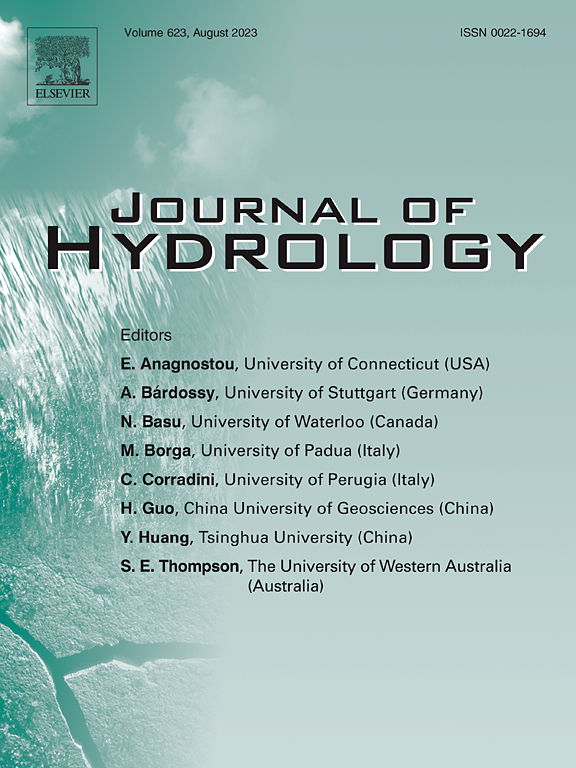A new externally coupled, physically-based multi-model framework for simulating subsurface and overland flow hydrological processes on hillslopes
IF 6.3
1区 地球科学
Q1 ENGINEERING, CIVIL
引用次数: 0
Abstract
This study presents an innovative, computationally efficient, and flexible physically-based multi-model framework that couples three well-established state-of-the-art models: HYDRUS-1D (H1D) for vadose zone flow, KINEROS2 (K2) for overland flow, and MODFLOW-2005 (MF5) for groundwater flow. The coupled model, called H1D-K2-MF5, implements advanced techniques, such as dynamic time-stepping, dimensionality reduction, and adaptive pressure head boundary condition switching, to ensure precise simulations of flow processes and interactions among the three modeling domains. The model simulates flow processes at a hillslope scale, including runoff, infiltration, recharge, evapotranspiration, soil moisture redistribution, and groundwater dynamics. Model accuracy and functionality were tested and validated against benchmark simulations and by comparisons with the integrated watershed (IW) model ParFlow. The simulation domains include uniform and heterogeneous hillslopes, as well as a complex hillslope with pumping and stream-aquifer interactions. Simulated time series of outflow rates, soil water contents, groundwater heads, and water balance analyses demonstrated high accuracy and consistency with the IW model. The new model ran 17–20 times faster than ParFlow, demonstrating substantial computational efficiency. Results confirm the reliable exchange of water fluxes between the coupled model components due to the implementation of a boundary condition switching algorithm based on surface ponding, which enables realistic infiltration simulation, and the adjustment of vadose zone pressure heads, ensuring accurate recharge flux estimates. The modular design of the H1D-K2-MF5 model allows for flexible configuration between surface water, vadose zone, and groundwater components depending on specific study objectives, thereby enhancing its adaptability for diverse hydrological applications. Further developments will include the addition of reactive solute transport at hillslopes and extending to large-scale watersheds.
一个新的外部耦合的、基于物理的多模型框架,用于模拟山坡上的地下和地面流水文过程
该研究提出了一种创新的、计算效率高、灵活的基于物理的多模型框架,该框架结合了三种成熟的最先进的模型:用于气相带流动的HYDRUS-1D (H1D)、用于地表流动的KINEROS2 (K2)和用于地下水流动的MODFLOW-2005 (MF5)。该耦合模型名为hdd - k2 - mf5,采用了动态时间步进、降维和自适应压头边界条件切换等先进技术,以确保精确模拟流动过程和三个建模域之间的相互作用。该模型模拟了坡面尺度下的水流过程,包括径流、入渗、补给、蒸散、土壤水分再分配和地下水动态。通过基准模拟和与综合流域(IW)模型ParFlow的比较,对模型的准确性和功能进行了测试和验证。模拟域包括均匀和非均匀山坡,以及具有抽水和河流-含水层相互作用的复杂山坡。模拟流出率、土壤含水量、地下水水头和水平衡分析的时间序列表明,与IW模型具有较高的准确性和一致性。新模型的运行速度比ParFlow快17-20倍,显示出可观的计算效率。结果证实了耦合模型组件之间可靠的水通量交换,因为实现了基于地表水池的边界条件切换算法,实现了真实的入渗模拟,并且调节了渗透区压力头,确保了准确的补给通量估计。hdd - k2 - mf5模型采用模块化设计,可根据具体研究目标,在地表水、水汽带和地下水组分之间进行灵活配置,从而增强了其对多种水文应用的适应性。进一步的发展将包括在山坡上增加反应性溶质运输,并扩展到大规模的流域。
本文章由计算机程序翻译,如有差异,请以英文原文为准。
求助全文
约1分钟内获得全文
求助全文
来源期刊

Journal of Hydrology
地学-地球科学综合
CiteScore
11.00
自引率
12.50%
发文量
1309
审稿时长
7.5 months
期刊介绍:
The Journal of Hydrology publishes original research papers and comprehensive reviews in all the subfields of the hydrological sciences including water based management and policy issues that impact on economics and society. These comprise, but are not limited to the physical, chemical, biogeochemical, stochastic and systems aspects of surface and groundwater hydrology, hydrometeorology and hydrogeology. Relevant topics incorporating the insights and methodologies of disciplines such as climatology, water resource systems, hydraulics, agrohydrology, geomorphology, soil science, instrumentation and remote sensing, civil and environmental engineering are included. Social science perspectives on hydrological problems such as resource and ecological economics, environmental sociology, psychology and behavioural science, management and policy analysis are also invited. Multi-and interdisciplinary analyses of hydrological problems are within scope. The science published in the Journal of Hydrology is relevant to catchment scales rather than exclusively to a local scale or site.
 求助内容:
求助内容: 应助结果提醒方式:
应助结果提醒方式:


